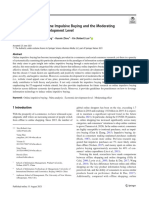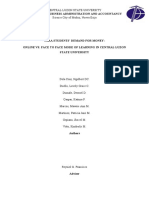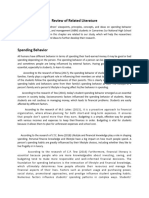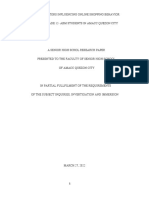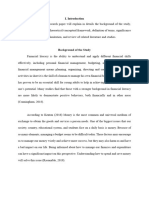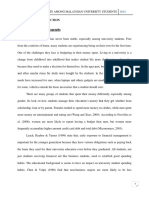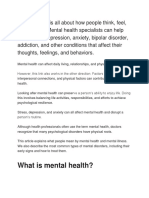0 ratings0% found this document useful (0 votes)
5 viewsPsychological a-WPS Office
Psychological a-WPS Office
Uploaded by
turdillojamesbanawaCopyright:
© All Rights Reserved
Available Formats
Download as DOCX, PDF, TXT or read online from Scribd
Psychological a-WPS Office
Psychological a-WPS Office
Uploaded by
turdillojamesbanawa0 ratings0% found this document useful (0 votes)
5 views2 pagesCopyright
© © All Rights Reserved
Available Formats
DOCX, PDF, TXT or read online from Scribd
Share this document
Did you find this document useful?
Is this content inappropriate?
Copyright:
© All Rights Reserved
Available Formats
Download as DOCX, PDF, TXT or read online from Scribd
Download as docx, pdf, or txt
0 ratings0% found this document useful (0 votes)
5 views2 pagesPsychological a-WPS Office
Psychological a-WPS Office
Uploaded by
turdillojamesbanawaCopyright:
© All Rights Reserved
Available Formats
Download as DOCX, PDF, TXT or read online from Scribd
Download as docx, pdf, or txt
You are on page 1of 2
Psychological and Behavioral Aspects.
Online shopping, due to its convenience, has become a
prominent habit, especially among students, impacting time allocation and focus. Research
reveals that compulsive buying behaviors, influenced by self-control, attentional biases, and
ease of access, could lead students to spend excessive time online, potentially affecting
academic priorities (Wenzi, 2021; Jiang et al., 2017). Generational differences further illustrate
how societal trends and internet adoption affect students' shopping habits (Lissitsa & Kol,
2016). Motivations and Acceptance of Online Shopping.Students engage in online shopping
driven by convenience, enjoyment, and efficient transaction processes. The Technology
Acceptance Model highlights these factors and points out that younger users may prioritize
quick solutions, though concerns around security and financial literacy remain, especially
among high school students (Liu & Forsythe, 2010; Zhou et al., 2011). Impact on Academic
Performance and Time Management.Online shopping offers advantages like time-saving and
reduced physical shopping trips; however, it may also lead to over-engagement, potentially
interfering with study time. Studies suggest that compulsive buying can disrupt students'
academic schedules, leading to poorer performance (Putman, 2015; Smith & Jones, 2018).
Additionally, ease of shopping may help students meet personal needs efficiently but could
cause financial and time management issues if not moderated (Johnson et al., 2018).Financial
Management and Independence.Online shopping offers budget-friendly options, potentially
promoting financial independence by enabling price comparisons and discounts. Martinez and
Garcia (2020) found that students benefit from competitive prices, fostering budgeting skills
and money management. Conversely, lack of financial discipline in online spending can lead to
debt, adding financial stress that might detract from academic focus (Brown et al.,
2019).Mental Health and Well-Being.Compulsive online shopping can serve as a coping
mechanism for stress and anxiety, potentially creating a vicious cycle where academic
challenges and financial strain exacerbate stress. Johnson and Smith (2020) observed that high-
stress students might turn to online shopping for temporary relief, which may further impair
their academic performance.COVID-19 Influence on Shopping Habits.The pandemic accelerated
online shopping habits, especially with lockdowns restricting access to physical stores. This shift
led students to embrace online shopping as a daily activity, possibly reinforcing habits that
could detract from academic performance if not managed properly (Nguyen et al., 2020; Sheth,
2020).Security concerns remain prominent, particularly regarding payment fraud and data
protection. Students, often less experienced in financial transactions, may face risks that lead to
financial losses and related stress, diverting attention from academic responsibilities
(Fernandez, 2016). Social Media and E-Commerce Influence.Social media has heightened the
appeal of online shopping through influencer marketing and targeted advertisements, which
may encourage students to spend impulsively. This dynamic promotes consumerism while
simultaneously distracting students from academic responsibilities (Chiaz, 2016; Kestenbaum,
2018).Educational Resource Accessibility.Despite potential downsides, online shopping aids
educational access, with students easily obtaining textbooks, digital content, and collaborative
learning tools. Such resources, highlighted by Anderson (2017), support academic growth and
provide supplementary learning options.
You might also like
- Budgeting and Spending Behaviors of AccountancyDocument9 pagesBudgeting and Spending Behaviors of AccountancyLyan50% (2)
- Concept PaperDocument20 pagesConcept PaperKarylle Young100% (1)
- Perceived Risk and Their Influences On Online ShoppingDocument13 pagesPerceived Risk and Their Influences On Online ShoppingneelfearlessNo ratings yet
- Teachers' Manual For ECCE & Early Grades Pre-PrimarymanualDocument77 pagesTeachers' Manual For ECCE & Early Grades Pre-PrimarymanualSwapnil KiniNo ratings yet
- Leadership That Gets Result SlidessDocument34 pagesLeadership That Gets Result SlidessNooray Malik100% (1)
- Grand SynthesisDocument2 pagesGrand SynthesisturdillojamesbanawaNo ratings yet
- CHAPTER 2 Online ShoppingDocument8 pagesCHAPTER 2 Online ShoppingturdillojamesbanawaNo ratings yet
- This ArticleDocument3 pagesThis ArticleturdillojamesbanawaNo ratings yet
- International University Students' Online Shopping BehaviourDocument17 pagesInternational University Students' Online Shopping BehaviourKhaireni PuspaningtyasNo ratings yet
- The Impact of Financial Stability and Online Impulsive Buying Behavior Among Selected Parents of AccountancyDocument17 pagesThe Impact of Financial Stability and Online Impulsive Buying Behavior Among Selected Parents of AccountancyFranklin CuratoNo ratings yet
- Research 4Document29 pagesResearch 4judeforstudNo ratings yet
- Reswaech IntroDocument4 pagesReswaech IntroBabieqt GowNo ratings yet
- V16N2s 91Document10 pagesV16N2s 91kissheysNo ratings yet
- Editing Introduction of ResearchDocument2 pagesEditing Introduction of Researchjanine mujeNo ratings yet
- Imrad T TDocument66 pagesImrad T Tasalangsang45No ratings yet
- Can Allowance Personal Budgeting and Self ControlDocument11 pagesCan Allowance Personal Budgeting and Self ControlAmazing WorldNo ratings yet
- Research AbmDocument32 pagesResearch AbmGabriel John AlviarNo ratings yet
- problemDocument10 pagesproblemalliyahanahawNo ratings yet
- Research 1Document25 pagesResearch 1alliyahfabre62No ratings yet
- Group 6 ResearchDocument4 pagesGroup 6 Researchdesireeelliso12No ratings yet
- Ge2 Research Final OutputDocument15 pagesGe2 Research Final Outputapi-711454599No ratings yet
- RRL ForeignDocument4 pagesRRL Foreignゔ違でStrawberry milkNo ratings yet
- Are There Significant Differences in The Saving and Spending Patterns Across Different Year Levels?Document24 pagesAre There Significant Differences in The Saving and Spending Patterns Across Different Year Levels?Andrea kate RoseroNo ratings yet
- Online Shopping Expenses of Students Before and During The PandemicDocument27 pagesOnline Shopping Expenses of Students Before and During The PandemicKristian ClarielNo ratings yet
- ResearchDocument9 pagesResearch202101132No ratings yet
- This Article ai-WPS OfficeDocument1 pageThis Article ai-WPS OfficeturdillojamesbanawaNo ratings yet
- The Impact of Financial Literacy On Budgeting Management Among Abm StudentsDocument12 pagesThe Impact of Financial Literacy On Budgeting Management Among Abm StudentsDatu Abdullah Sangki Mps100% (2)
- The Importance of Financial Management FDocument7 pagesThe Importance of Financial Management FJM MagsayoNo ratings yet
- Kokiii ResearchcDocument41 pagesKokiii ResearchckrissanglimbagoNo ratings yet
- Antecedents of Online Impulse Buying Behavior - An Empirical Study in IndonesiaDocument22 pagesAntecedents of Online Impulse Buying Behavior - An Empirical Study in IndonesiashubhakarNo ratings yet
- Spending Habits Among Malaysian University StudentsDocument22 pagesSpending Habits Among Malaysian University StudentsFernando Mikhail QuintosNo ratings yet
- Pengaruh Literasi Keuangan Dan Belanja Online Terhadap Perilaku Konsumtif MahasiswaDocument19 pagesPengaruh Literasi Keuangan Dan Belanja Online Terhadap Perilaku Konsumtif Mahasiswaanugrah ardhanaNo ratings yet
- Factors Affecting The Decision of The Second-Year IT Students To Shop Online. (AutoRecovered)Document19 pagesFactors Affecting The Decision of The Second-Year IT Students To Shop Online. (AutoRecovered)Reng Carlo CadornaNo ratings yet
- introduction-draft-2Document3 pagesintroduction-draft-2pcloma031No ratings yet
- Financial LiteracyDocument9 pagesFinancial Literacygwynlumactod2No ratings yet
- Comparative Study On The Perception of Bsba Student Buyers Between Online and Physical Clothing StoresDocument8 pagesComparative Study On The Perception of Bsba Student Buyers Between Online and Physical Clothing StoresYour Academic ServantNo ratings yet
- RRL Quanti RevDocument20 pagesRRL Quanti RevZyrine SantosNo ratings yet
- SEMINAR COMPILED - LatestDocument37 pagesSEMINAR COMPILED - LatestEydaa RahmanNo ratings yet
- Group 3 Introduction RRLDocument26 pagesGroup 3 Introduction RRLYumekoo JabamiNo ratings yet
- Paper G11Document50 pagesPaper G11Giean PajarilloNo ratings yet
- ForeinDocument1 pageForeinMAYINo ratings yet
- Factors Influencing The Online ShoppingDocument16 pagesFactors Influencing The Online ShoppingRD SuarezNo ratings yet
- Review of Related LiteratureDocument6 pagesReview of Related Literaturewilfredandrewagustin100% (3)
- The Problem Elements Activity 1 Docx Group4.Document7 pagesThe Problem Elements Activity 1 Docx Group4.vergeltante407No ratings yet
- ResearchDocument30 pagesResearchKen LlenaNo ratings yet
- Eloise Marie Juguilon IMPULSIVEDocument29 pagesEloise Marie Juguilon IMPULSIVEFashiel Mae JuguilonNo ratings yet
- Online Shopping Platforms Influence in Consumer Behavior PDFDocument21 pagesOnline Shopping Platforms Influence in Consumer Behavior PDFortizjoanna572No ratings yet
- Background of The StudyDocument3 pagesBackground of The StudyVince Laurence BlancaflorNo ratings yet
- ResearchDocument16 pagesResearchmargarette.donato16No ratings yet
- Calonia Gwapa Sending Habits RRLDocument3 pagesCalonia Gwapa Sending Habits RRLdaisydadatNo ratings yet
- Consumer Perception FinalDocument15 pagesConsumer Perception FinalAaron James BacudNo ratings yet
- Group 3 ResearchDocument13 pagesGroup 3 Researchjohndale gtNo ratings yet
- Argumentative Essay-Online EducationDocument2 pagesArgumentative Essay-Online EducationOmar MikailovNo ratings yet
- 12-HUMSS A (PAMOT'S GROUP)Document33 pages12-HUMSS A (PAMOT'S GROUP)joejean.templanzaNo ratings yet
- International Journal of Entrepreneurship and Development Studies (IJEDS)Document10 pagesInternational Journal of Entrepreneurship and Development Studies (IJEDS)zorouchiha1989No ratings yet
- Chapter 123Document44 pagesChapter 123Honey VenidaNo ratings yet
- Bae, Jang 2023Document29 pagesBae, Jang 2023verča opletalovaNo ratings yet
- Spending Habits Among Malaysian UniversiDocument21 pagesSpending Habits Among Malaysian UniversiNajmi Sidik100% (1)
- Navigating Change; Strategies for Parents and Investors in 2025From EverandNavigating Change; Strategies for Parents and Investors in 2025No ratings yet
- A Qualitative Case Study of Best Practices in Holistic EducationFrom EverandA Qualitative Case Study of Best Practices in Holistic EducationNo ratings yet
- Leadership in Continuing Education in Higher EducationFrom EverandLeadership in Continuing Education in Higher EducationNo ratings yet
- The New Education - Fighting Technology (and Boredom) for the Attention of StudentsFrom EverandThe New Education - Fighting Technology (and Boredom) for the Attention of StudentsNo ratings yet
- Split_20241124_2008_1Document2 pagesSplit_20241124_2008_1turdillojamesbanawaNo ratings yet
- Volume 8, Issue-WPS OfficeDocument8 pagesVolume 8, Issue-WPS OfficeturdillojamesbanawaNo ratings yet
- CultureDocument11 pagesCultureturdillojamesbanawaNo ratings yet
- Ucsp Group2Document12 pagesUcsp Group2turdillojamesbanawaNo ratings yet
- UCSP Kinship and MarriageDocument33 pagesUCSP Kinship and MarriageturdillojamesbanawaNo ratings yet
- RelatedDocument3 pagesRelatedturdillojamesbanawaNo ratings yet
- Rrs Wps OfficeDocument3 pagesRrs Wps OfficeturdillojamesbanawaNo ratings yet
- The Role of Ai RRLDocument6 pagesThe Role of Ai RRLturdillojamesbanawaNo ratings yet
- According To an-WPS OfficeDocument5 pagesAccording To an-WPS OfficeturdillojamesbanawaNo ratings yet
- Economic ResourcesDocument62 pagesEconomic ResourcesturdillojamesbanawaNo ratings yet
- 4Q Model PPT FinalDocument9 pages4Q Model PPT FinalParixit Das0% (1)
- Troll Et Al. Preprint How Students Self Control and Smartphone Use Explain Their Academic PerformanceDocument34 pagesTroll Et Al. Preprint How Students Self Control and Smartphone Use Explain Their Academic PerformanceykaaNo ratings yet
- Dominate LifeDocument10 pagesDominate LifeTojiNo ratings yet
- Maroda (2010) Psychodynamic Techniques. Chapter 6 - Managing EmotionsDocument11 pagesMaroda (2010) Psychodynamic Techniques. Chapter 6 - Managing EmotionsChristine YauNo ratings yet
- NCP LeprosyDocument3 pagesNCP LeprosyJane MinNo ratings yet
- 6 2 Scenario Analysis Vacation TimeDocument5 pages6 2 Scenario Analysis Vacation TimeOrago AjaaNo ratings yet
- 202 - The Teacher, The Learner and The Learning Process A Triology To Effective TeachingDocument20 pages202 - The Teacher, The Learner and The Learning Process A Triology To Effective TeachingPatrick anthony Vales100% (2)
- Re-Constructive Therapy - An OverviewDocument11 pagesRe-Constructive Therapy - An OverviewNizamNo ratings yet
- Salovey Si Mayer, 1990 Importanta Intel Emotionale PDFDocument27 pagesSalovey Si Mayer, 1990 Importanta Intel Emotionale PDFAnaida FilipoiuNo ratings yet
- Intro To Wellness-Lesson 2-Health Is...... UPDATEDdocxDocument2 pagesIntro To Wellness-Lesson 2-Health Is...... UPDATEDdocxAaron LewisNo ratings yet
- Brand Management (Week 2 MCQ)Document20 pagesBrand Management (Week 2 MCQ)tanmoy mandalNo ratings yet
- Šta Je RezilijentnostDocument2 pagesŠta Je RezilijentnostAlex Maric DragasNo ratings yet
- Jae 201174012905Document5 pagesJae 201174012905Adrian KhomanNo ratings yet
- Chapter Three Behaviour Disorders: September 2019Document12 pagesChapter Three Behaviour Disorders: September 2019chaib smailNo ratings yet
- Cony Anggreini, Daharnis, Daharnis, Yeni Karneli: DOI: 10.24036/00103za0002Document6 pagesCony Anggreini, Daharnis, Daharnis, Yeni Karneli: DOI: 10.24036/00103za0002Jufrida JufridaNo ratings yet
- Mental Health Is All About How People ThinkDocument5 pagesMental Health Is All About How People ThinkresyaniNo ratings yet
- Outline:: Topic: My Hobby Thesis: Telling About My Hobbies Method of Paragraph: ArgumentativeDocument2 pagesOutline:: Topic: My Hobby Thesis: Telling About My Hobbies Method of Paragraph: ArgumentativeKalebNo ratings yet
- Marzano and KendallDocument7 pagesMarzano and KendallXhiemay Ereno50% (6)
- Final Brochure - UbikaDocument23 pagesFinal Brochure - UbikaHimanshu KandpalNo ratings yet
- Achievement Motivation ExplanationDocument23 pagesAchievement Motivation ExplanationSimon Dzokoto100% (1)
- Negotiation SkillsDocument26 pagesNegotiation SkillsRahul JhaNo ratings yet
- Antecedents and Consequences of Emotional Attachment To Sport Teams BrandsDocument16 pagesAntecedents and Consequences of Emotional Attachment To Sport Teams BrandsTommaso CorsoNo ratings yet
- STRUCT AESTHETICS Principles-NotesDocument3 pagesSTRUCT AESTHETICS Principles-NotesANSLEM ALBERTNo ratings yet
- The 21St Century: Instructional LeaderDocument76 pagesThe 21St Century: Instructional LeaderJohn AmbasNo ratings yet
- A Presentation On Job Enrichment: Presented by C.SravanthiDocument9 pagesA Presentation On Job Enrichment: Presented by C.SravanthiChandra SravanthiNo ratings yet
- Assessment and Learning Beed Iii-2Document5 pagesAssessment and Learning Beed Iii-2Jeremiah100% (1)
- PORTFOLIO - ADVANCED 5 -JADE ANDREA QUISPE CRUZDocument17 pagesPORTFOLIO - ADVANCED 5 -JADE ANDREA QUISPE CRUZJade Quispe CruzNo ratings yet
- First Quarter Exam in Oral CommunicationDocument2 pagesFirst Quarter Exam in Oral CommunicationZAIRAN AYOB TY100% (4)





























